Seasonal and Geographic Dynamics in Bioproperties and Phytochemical Profile of Limonium algarvense Erben
Abstract
:1. Introduction
2. Results and Discussion
2.1. Phenolic Composition
| ID | Rt (min) | Proposed Ion Structure (M-H)− | [M-H]− [m/z (Δ ppm)] | MS2 Main-Ion [Relative Intensity (%)] | Proposed Compound | Winter | Spring | Summer | Autumn | Ref. | ||||
|---|---|---|---|---|---|---|---|---|---|---|---|---|---|---|
| A | B | A | B | A | B | A | B | |||||||
| 1 | 0.9 | - | 272.9472 | 180.9572 (100) | Unknown | + | + | + | + | + | + | + | + | [12] |
| 2 | 0.9 | C12H21O11 | 341.1087 (+4.5) | - | Galactinol | + | + | + | + | + | + | + | + | [43] |
| 3 | 1.0 | C12H21O11· 2(H2O) | 377.0875, 341.1074 (+4.5) [M-H-2(H2O)]− | 341.1074 (100), 179.0569 (20) | Galactinol dihydrate | ++ | +++ | +++ | +++ | ++ | ++ | +++ | +++ | [44] |
| 4 | 1.5 | C13H9O8 | 293.0311 (−2.7) | 121.0502 (100) | Pyrogallol gallate | + | + | +/− | +/− | +/− | +/− | +/− | +/− | [12] |
| 5 | 2.6 | C13H15O10SO3 | 411.0221 (+4.3) | 240.9997 (100), 331.0607 (34) 169.0134 (13) | Glucogallin sulphate | + | + | +/− | +/− | +/− | +/− | + | + | [12] |
| 6 | 3.4 | C15H19O10SO3 | 439.0535 (+3.8) | 241.0115 (100) 198.0794 (41) | Glucosyringic acid sulphate | +/− | +/− | +/−− | +/−− | +/− | +/− | +/− | +/− | [12] |
| 7 | 4.7 | C15H17O8SO3 | 405.0480 (+4.2) | 240.9830 (80) 341.9238 (31) | Glucosyl coumaric acid sulphate | + | + | + | + | + | + | + | + | [12] |
| 8 | 5.1 | 365.0151 | 210.9808 (100) 97.0595 (48) 139.1229 (38) | Unknown | + | + | +/− | +/− | +/− | +/− | + | + | ||
| 9 | 6.5 | C15H17O8SO3 | 405.0488 (+2.2) | 240.9992 (100) 97.0492 (61) 271.044 (42) | Glucosyl coumaric acid sulphate isomer | + | + | + | + | + | + | + | + | [12] |
| 10 | 7.6 | 259.0275 | 166.6115 (100) | Unknown | +/−− | +/− | +/−− | +/−− | − | +/−− | +/−− | +/−− | ||
| 11 | 8.4 | 441.1602 | 174.9519 (100), 381.1242 (72), 276.9178 (67) | Unknown | − | +/− | − | +/− | − | +/− | − | +/− | ||
| 12 | 8.5 | 463.1427 | 293.0865 (100), 348.8434 (63), 315.9599 (56) | Unknown | +/− | − | +/− | − | +/− | − | +/− | − | ||
| 13 | 9.2 | C37H29O18 | 761.1366 (−0.9) | 423.0676 (100), 305.0622 (71), 609.1168 (24) | Theasinensin B | +/− | + | +/− | + | +/− | + | +/− | + | [12] |
| 14 | 9.8 | C17H29O10 | 393.1741 (+6.4) | 179.0441 (100), 205.0639 (71), 197.4096 (67) | Hex-3-en-olxylopyranosyl- (1-6)-glucopyranoside | − | − | − | − | ++ | + | − | − | [10] |
| 15 | 10.3 | C37H27O18 | 759.1191 (+1.6) | 423.0714 (100), 301.0297 (67), 345.0175 (63), 481.0677 (33) | ProdelphinidinA2 3′-gallate | + | + | +/− | +/− | +/− | +/− | + | + | [12] |
| 16 | 11.3 | C21H21O11 | 449.1062 (+6.1) | 287.0521 (100), 269.0352 (92) | Eriodyctiol-O-glucoside | +/−− | +/−− | +/−− | +/−− | +/−− | +/−− | +/−− | +/−− | [10] |
| 18 | 12 | C22H17O11 | 457.0758 (+4.0) | 305.0611 (100), 169.0127 (64) | Epigallocatechin gallate | + | + | + | + | + | + | + | + | [10] |
| 19 | 12.5 | 385.1116 | 267.0685 (100) | Unknown | +/− | +/− | +/− | +/− | +/− | +/− | +/− | +/− | ||
| 20 | 12.6 | 431.1909 | Unknown | +/− | − | +/− | − | +/− | − | +/− | − | |||
| 21 | 12.9 | C28H23O17 | 631.0941 (−0.1) | 479.0799 (100), 316.0175 (55) | Myricetin-3-O-galloyl-hexoside | +++ | +++ | +++ | +++ | +++ | +++ | +++ | +++ | [10,12] |
| 22 | 13.5 | 539.2144 | 491.1935 (100), 195.0645 (32), 329.1318 (22), 343.1460 (20) | Unknown | +/− | +/− | +/− | +/− | +/− | +/− | +/− | +/− | ||
| 23 | 13.6 | C27H29O17 | 625.1397 (+2.1) | 316.0154 (100), 287.0172 (20), 271.01630 (17) | Myricetin-3-O-rutinoside | +/− | + | + | +/− | +/− | +/− | +/− | + | [12] |
| 24 | 13.7 | C21H19O13 | 479.0820 (+2.3) | 316.0187 (100), 271.0211 (6) | Myricetin-O-glucoside | +++ | +++ | +++ | +++ | +++ | +++ | +++ | +++ | [10,12] |
| 25 | 13.9 | C21H19O13 | 479.0823 (+1.7) | 316.0181 (100), 271.0204 (5) | Myricetin-O-glucoside (isomer) | ++ | ++ | ++ | ++ | ++ | ++ | ++ | ++ | [10,12] |
| 26 | 14.8 | C28H23O16 | 615.0991 (0) | 463.0846 (100), 300.0238 (30), 301.0309 (21), 271.0202 (15) | Quercetin-3-O-galloyl-hexoside | +/− | +/− | +/− | +/− | +/− | +/− | +/− | +/− | [10,12] |
| 27 | 15.1 | C28H23O16 | 615.0993 (−0.2) | 463.0870 (100), 300.0227 (37), 301.0325 (36), 271.0206 (36) | Quercetin-3-O-galloyl-hexoside (isomer) | + | + | + | + | + | + | + | + | [10,12] |
| 28 | 15.3 | C20H17O12 | 449.0707 (+4.2) | 316.0186 (100), 317.0227 (34), 271.0192 (9) | Myricetin-3-O-pentoside | +/− | +/− | +/− | +/− | +/− | +/− | +/− | +/− | [10] |
| 29 | 15.5 | C21H19O12 | 463.0866 (+3.5) | 316.0179 (100), 317.0232 (33), 271.0180 (7) | Myricetin-3-O-rhamnoside | ++ | +++ | ++ | +++ | ++ | +++ | ++ | +++ | [10,12] |
| 30 | 15.7 | C21H19O12 | 463.0870 (+2.7) | 300.0236 (100), 301.0285 (41), 316.0180 (26), 271.0208 (11) | Quercetin-O-hexoside | + | + | + | + | + | + | + | + | [10] |
| 31 | 15.9 | C27H33O15 | 597.1818 (+1.1) | 387.1077 (100), 357.0951 (92), 417.1151 (35), 459.1230 (11) | Quercetin-tetramethyl ether-dihydroxyethyl-fructopyranose | +/− | +/− | +/− | +/− | +/− | +/− | +/− | +/− | [10] |
| 32 | 16.1 | C21H19O12 | 463.0866 (+3.5) | 300.0216 (100), 301.0305 (52), 316.0177 (28), 271.0192 (7) | Quercetin-O-hexoside isomer | + | + | + | + | + | + | + | + | [10] |
| 33 | 16.2 | C30H27O17 | 659.1253 (+0.1) | 316.0178 (100), 317.0225 (29), 287.0164 (13), 271.0175 (13) | Myricetin-3-O-(3-caffeic acid-glucoside) | +/−− | +/−− | +/− | +/− | +/− | +/− | +/−− | +/−− | |
| 34 | 16.4 | C18H17O7SO3 | 425.0530 (+4.2) | 300.0608 (100), 315.0797 (48), 345.1509 (26) | 3′,4′,5′-Trimethoxyflavanone sulphate | + | + | + | + | + | + | + | + | [12] |
| 35 | 16.6 | C22H25O8SO3 | 497.1116 (+1.4) | 417.1541 (100), 402.1316 (44), 418.1583 (24), 387.1017 (18) 181.0492 (16) | Syringaresinol sulphate | ++ | ++ | + | + | ++ | ++ | ++ | ++ | [12] |
| 36 | 16.6 | C21H23O7SO3 | 467.1001 (+3.5) | 387.1383 (100), 372.1181 (73), 181.0508 (30), 357.0943 (23) | Medioresinol sulphate | + | + | +/− | +/− | + | + | + | + | [12] |
| 37 | 16.8 | C21H19O12 | 463.0868 (+3.1) | 301.0292 (100), 300.0206 (44) | Quercetin-O-hexoside isomer | − | − | − | − | + | +/− | − | − | [12] |
| 38 | 17.3 | 583.1482 | 309.0322 (91), 322.8592 (86), 291.0268 (77), 65.7793 (77) | Unknown | +/− | +/− | +/− | +/− | +/− | +/− | +/− | +/− | ||
| 39 | 17.7 | C20H21O6SO3 | 437.0905 (+1.6) | 357.1322 (100), 342.1076 (53), 422.0608 (10), 151.0454 (3) | Pinoresinol sulphate | +++ | +++ | +++ | +++ | +++ | +++ | +++ | +++ | [10,12] |
| 40 | 17.9 | C21H19O11 | 447.0921 (+2.6) | 300.0229 (100), 301.0306 (66), 271.0188 (12) | Quercetin-3-O-rhamnoside | + | + | + | + | + | + | + | + | [10] |
| 41 | 18.1 | C21H19O10 | 431.0966 (+4.1) | 268.0334 (100), 269.0405 (40) | Apigenin-O-glucoside | − | − | − | − | ++ | + | +/− | +/− | [10] |
| 42 | 18.4 | C21H17O11 | 445.0755 (+4.8) | 269.0404 (100) | Apigenin-O-glucuronide | − | − | − | − | +++ | ++ | + | + | [10,12] |
| 43 | 18.6 | C27H35O12 | 551.2130 (+0.6) | 357.1265 (100) | Pinoresinol derivative | +/− | +/− | +/− | +/− | − | − | +/−− | +/−− | [12] |
| 44 | 18.9 | C20H21O6SO3 | 437.0897 (+3.3) | 357.1283 (100), 342.1063 (92) | Pinoresinol sulphate isomer | + | + | + | + | + | + | + | + | [10,12] |
| 45 | 19.7 | C27H35O12 | 551.2137 (−0.5) | 357.1226 (100), 165.0621 (95), 195.0632 (92), 438.8498 (38), 505.2076 (34) | Pinoresinol derivative | + | + | + | + | + | + | + | + | [12] |
| 46 | 19.9 | C28H23O16 | 615.0992 (−0.1) | 317.0261 (100), 287.0180 (3), 463.0856 (3) | Myricetin-O-(galloyl)-deoxyhexose | +/− | + | + | + | + | + | + | + | [10] |
| 47 | 20 | C21H19O10 | 431.0973 (+2.5) | 284.0341 (100), 255.0201 (32) | Luteolin-7-O-rhamnoside | +/− | +/− | +/− | +/− | + | +/− | +/− | +/− | [10] |
| 48 | 20.5 | C27H33O12 | 549.1978 (−0.1) | 355.1193 (100), 521.2029 (84), 193.0412 (73) | Lignan glycoside | + | + | + | + | +/− | +/− | + | +/− | [45,46] |
| 49 | 21 | C26H31O10 | 503.1924 (−0.3) | 335.4861 (100), 306.8672 (80), 426.7623 (65) | Lignan glycoside | +/− | +/− | +/− | +/− | +/−− | +/−− | +/− | +/− | [47] |
| 50 | 22.3 | C25H23O13 | 531.1122 (+4.2) | 316.0170 (100), 317.0207 (29), 271.0193 (6), 287.0174 (5) | Myricetin derivative | +/−− | +/− | + | + | +/− | +/− | − | − | |
| 51 | 22.5 | C26H27O14 | 563.1421 (−2.6) | 316.0197 (100), 317.0233 (24) | Myricetin derivative | +/−− | +/− | +/−− | +/− | +/−− | +/− | +/−− | +/−− | |
| 52 | 22.9 | C15H9O6 | 285.0381 (+8.2) | 124.1813 (91), 180.9969 (91), 216.9228 (74) | Luteolin | − | − | − | − | +/− | − | − | − | [12] |
| 53 | 25.4 | C15H11O5 | 271.0590 (+8.0) | 85.0673 (100), 150.5868 (35) | Naringenin | − | − | − | − | + | + | +/−− | +/− | [10,12] |
| 54 | 26.2 | C18H31O5 | 327.2161 (+5.0) | 283.2492 (100) | Trihydroxy-10,15-octadecadienoic acid | +/− | +/− | +/− | +/− | + | +/− | +/− | +/− | [10,12] |
| 55 | 28.2 | C18H33O5 | 329.2313 (+6.3) | - | Trihydroxy-10-octadecenoic acid | +/− | +/− | +/− | +/− | +/− | +/− | +/− | +/− | [10,12] |
2.2. Antioxidant Properties
2.3. Anti-Inflammatory Properties
2.4. Principal Component Analysis (PCA)
3. Materials and Methods
3.1. Sample Collection and Processing
3.2. Extracts Preparation
3.3. Phytochemical Profiling
3.3.1. Contents in Total Phenolic (TPC), Flavonoid, and Condensed Tannins (CTC)
3.3.2. Analysis by Liquid Chromatography Electrospray Ionization Quadrupole Time-of-Flight Mass Spectrometry (LC-ESI-QTOF-MS/MS)
3.4. Biological Properties
3.4.1. In Vitro Antioxidant Activity
3.4.2. In Vitro Anti-Inflammatory Activity
3.5. Statistical Analysis
4. Conclusions
Author Contributions
Funding
Institutional Review Board Statement
Informed Consent Statement
Data Availability Statement
Conflicts of Interest
References
- Erben, M. Limonium Mill. In Flora Iberica; Castroviejo, S., Aedo, C., Cirujano, S., Lainz, M., Montserrat, P., Morales, R., Garmendia, F.M., Navarro, C., Paiva, J., Soriano, C., Eds.; Real Jardín Botánico, CSIC: Madrid, Spain, 1993; pp. 2–143. [Google Scholar]
- Kubitzki, K. Plumbaginaceae. In Flower. Plants Dicotyledons; Kubitzki, K., Rohwer, J., Bittrich, V., Eds.; Springer: Berlin/Heidelberg, Germany, 1993; pp. 523–530. [Google Scholar]
- Rana, A.; Samtiya, M.; Dhewa, T.; Mishra, V.; Aluko, R.E. Health benefits of polyphenols: A concise review. J. Food Biochem. 2022, 46, e14264. [Google Scholar] [CrossRef]
- Felter, H.W.; Lloyd, J.U. King’s American Dispensatory, 18th ed.; Ohio Valley Co.: Cincinnati, OH, USA, 1898. [Google Scholar]
- Gancedo, N.C.; Isolani, R.; de Oliveira, N.C.; Nakamura, C.V.; de Medeiros Araújo, D.C.; Sanches, A.C.C.; Tonin, F.S.; Fernandez-Llimos, F.; Chierrito, D.; de Mello, J.C.P. Chemical Constituents, Anticancer and Anti-Proliferative Potential of Limonium Species: A Systematic Review. Pharmaceuticals 2023, 16, 293. [Google Scholar] [CrossRef]
- Erben, M. Die Gattung Limonium im südwestmediterranen Raum. Mitt. Bot. Staatssamml. München 1978, 14, 361–626. [Google Scholar]
- Cortinhas, A.; Erben, M.; Paes, A.P.; Espirito Santo, D.; Guara-Requena, M.; Caperta, A.D. Taxonomic complexity in the halophyte Limonium vulgare and related taxa (Plumbaginaceae): Insights from analysis of morphological, reproductive and karyological data. Ann. Bot. 2015, 115, 369383. [Google Scholar]
- Rodrigues, M.J.; Soszynski, A.; Martins, A.; Rauter, A.P.; Neng, N.R.; Nogueira, J.M.F.; Varela, J.; Barreira, L.; Custódio, L. Unravelling the antioxidant potential and the phenolic composition of different anatomical organs of the marine halophyte Limonium algarvense. Ind. Crops Prod. 2015, 77, 315–322. [Google Scholar] [CrossRef]
- Rodrigues, M.J.; Neves, V.; Martins, A.; Rauter, A.P.; Neng, N.R.; Nogueira, J.M.F.; Varela, J.; Barreira, L.; Custódio, L. In vitro antioxidant and anti-inflammatory properties of Limonium algarvense flowers’ infusions and decoctions: A comparison with green tea (Camellia sinensis). Food Chem. 2016, 200, 322–329. [Google Scholar] [CrossRef] [PubMed]
- Rodrigues, M.J.; Oliveira, M.; Neves, V.; Ovelheiro, A.; Pereira, C.; Neng, N.R.; Nogueira, J.M.F.; Varela, J.; Barreira, L.; Custódio, L. Coupling sea lavender (Limonium algarvense Erben) and green tea (Camellia sinensis (L.) Kuntze) to produce an innovative herbal beverage with enhanced enzymatic inhibitory properties. S. Afr. J. Bot. 2019, 120, 87–94. [Google Scholar]
- Rodrigues, M.J.; Monteiro, I.; Castañeda-Loaiza, V.; Placines, C.; Oliveira, M.C.; Caperta, A.D.; Pousão-Ferreira, P.; Pereira, C.; Custódio, L. Growth performance, in vitro antioxidant properties and chemical composition of the halophyte Limonium algarvense Erben are strongly influenced by the salinity irrigation. Ind. Crops Prod. 2020, 143, 111930. [Google Scholar] [CrossRef]
- Rodrigues, M.J.; Castañeda-Loaiza, V.; Monteiro, I.; Pinela, J.; Barros, L.; Abreu, R.M.V.; Oliveira, M.C.; Reis, C.; Soares, F.; Pousão-Ferreira, P.; et al. Metabolomic profile and biological properties of sea lavender (Limonium algarvense Erben) plants cultivated with aquaculture wastewaters: Implications for its use in herbal formulations and food additives. Foods 2021, 10, 3104. [Google Scholar] [CrossRef]
- Sharifi-Rad, M.; Anil Kumar, N.V.; Zucca, P.; Varoni, E.M.; Dini, L.; Panzarini, E.; Rajkovic, J.; Tsouh Fokou, P.V.; Azzini, E.; Peluso, I.; et al. Lifestyle, oxidative stress, and antioxidants: Back and forth in the pathophysiology of chronic diseases. Front. Physiol. 2020, 11, 694. [Google Scholar]
- Pizzino, G.; Irrera, N.; Cucinotta, M.; Pallio, G.; Mannino, F.; Arcoraci, V.; Squadrito, F.; Altavilla, D.; Bitto, A. Oxidative stress: Harms and benefits for human health. Oxidative Med. Cell. Longev. 2017, 2017, 8416763. [Google Scholar] [PubMed]
- Chaudhary, P.; Janmeda, P.; Docea, A.O.; Yeskaliyeva, B.; Abdull Razis, A.F.; Modu, B.; Calina, D.; Sharifi-Rad, J. Oxidative stress, free radicals and antioxidants: Potential crosstalk in the pathophysiology of human diseases. Front. Chem. 2023, 11, 1158198. [Google Scholar] [CrossRef] [PubMed]
- Christodoulou, M.C.; Orellana Palacios, J.C.; Hesami, G.; Jafarzadeh, S.; Lorenzo, J.M.; Domínguez, R.; Moreno, A.; Hadidi, M. Spectrophotometric Methods for Measurement of Antioxidant Activity in Food and Pharmaceuticals. Antioxidants 2022, 11, 2213. [Google Scholar] [CrossRef] [PubMed]
- Pahwa, R.; Goyal, A.; Jialal, I. Chronic Inflammation. In StatPearls; [Internet]; StatPearls Publishing: Treasure Island, FL, USA, 2022. Available online: https://www.ncbi.nlm.nih.gov/books/NBK493173/ (accessed on 15 November 2023).
- Predonzani, A.; Calì, B.; Agnellini, A.H.; Molon, B. Spotlights on immunological effects of reactive nitrogen species: When inflammation says nitric oxide. World J. Exp. Med. 2015, 5, 64–76. [Google Scholar] [CrossRef] [PubMed]
- Ramakrishna, A.; Ravishankar, G.A. Influence of abiotic stress signals on secondary metabolites in plants. Plant Signal. Behav. 2011, 6, 1720–1731. [Google Scholar]
- Lee, J.-S.; Kim, J.-W. Dynamics of zonal halophyte communities in salt marshes in the world. J. Mar. Isl. Cult. 2018, 7, 84–106. [Google Scholar] [CrossRef]
- Yang, L.; Wen, K.S.; Ruan, X.; Zhao, Y.X.; Wei, F.; Wang, Q. Response of plant secondary metabolites to environmental factors. Molecules 2018, 23, 762. [Google Scholar] [CrossRef]
- Soni, U.; Brar, S.; Gauttam, V.K. Effect of seasonal variation on secondary metabolites of medicinal plants. Int. J. Pharm. Sci. Res. 2015, 6, 3654–3662. [Google Scholar]
- García-Díaz, Y.D.; Aquino-Bolaños, E.N.; Chávez-Servia, J.L.; Vera-Guzmán, A.M.; Carrillo-Rodríguez, J.C. Bioactive compounds and antioxidant activity in the common bean are influenced by cropping season and genotype. Chil. J. Agric. Res. 2018, 78, 255–265. [Google Scholar]
- Bakhshi, S.; Abbaspour, H.; Saeidisar, S. Study of phytochemical changes, enzymatic and antioxidant activity of two halophyte plants: Salsola dendroides Pall and Limonium reniforme (Girard) Lincz in different seasons. Bulg. Chem. Commun. 2018, 50, 374–382. [Google Scholar]
- Souid, A.; Bellani, L.; Magné, C.; Zorrig, W.; Smaoui, A.; Abdelly, C.; Longo, V.; ben Hamed, K. Physiological and antioxidant responses of the sabkha biotope halophyte Limonium delicatulum to seasonal changes in environmental conditions. Plant Physiol. Biochem. 2018, 123, 180–191. [Google Scholar] [CrossRef] [PubMed]
- Mahmoudi, M.; Boughalleb, F.; Maaloul, S.; Zaidi, S.; Bakhshandeh, E.; Abdellaoui, R. The effect of seasonality on the phytochemical composition of two Limonium species naturally growing in a Mediterranean arid-salt marsh: Harvesting time optimization by modeling approach. Sci. Hortic. 2023, 309, 111616. [Google Scholar] [CrossRef]
- Kumar, K.; Debnath, P.; Singh, S.; Kumar, N. An Overview of Plant Phenolics and Their Involvement in Abiotic Stress Tolerance. Stresses 2023, 3, 570–585. [Google Scholar] [CrossRef]
- Woodward, F.I.; Woodward, F. Climate and Plant Distribution; Cambridge University Press: Cambridge, UK, 1987. [Google Scholar]
- Hasanuzzaman, M.; Nahar, K.; Alam, M.M.; Roychowdhury, R.; Fujita, M. Physiological, biochemical, and molecular mechanisms of heat stress tolerance in plants. Int. J. Mol. Sci. 2013, 14, 9643–9684. [Google Scholar] [CrossRef]
- Ritonga, F.N.; Chen, S. Physiological and Molecular Mechanism Involved in Cold Stress Tolerance in Plants. Plants 2020, 9, 560. [Google Scholar] [CrossRef]
- Demonsais, L.; Utz-Pugin, A.; Loubéry, S.; Lopez-Molina, L. Identification of tannic cell walls at the outer surface of the endosperm upon Arabidopsis seed coat rupture. Plant Mol. Biol. 2020, 104, 567–580. [Google Scholar] [CrossRef]
- Šamec, D.; Karalija, E.; Šola, I.; Vujčić Bok, V.; Salopek-Sondi, B. The Role of Polyphenols in Abiotic Stress Response: The Influence of Molecular Structure. Plants 2021, 10, 118. [Google Scholar] [CrossRef]
- Mathesius, U. Flavonoid Functions in Plants and Their Interactions with Other Organisms. Plants 2018, 7, 30. [Google Scholar] [CrossRef]
- Markham, K.R.; Ryan, K.G.; Bloor, S.G.; Mitchell, K.A. An increase in luteolin: Apigenin ratio in Marchantia polymorpha on UV-B enhancement. Phytochemistry 1998, 48, 791–794. [Google Scholar] [CrossRef]
- Dias, M.C.; Pinto, D.C.G.A.; Silva, A.M.S. Plant Flavonoids: Chemical Characteristics and Biological Activity. Molecules 2021, 26, 5377. [Google Scholar] [CrossRef]
- Semwal, D.K.; Semwal, R.B.; Combrinck, S.; Viljoen, A. Myricetin: A dietary molecule with diverse biological activities. Nutrients 2016, 8, 90. [Google Scholar] [PubMed]
- Jang, W.Y.; Kim, M.-Y.; Cho, J.Y. Antioxidant, anti-inflammatory, anti-menopausal, and anti-cancer effects of lignans and their metabolites. Int. J. Mol. Sci. 2022, 23, 15482. [Google Scholar] [PubMed]
- Clariant-Discover Galactinol Advanced the Biomimetic Booster of Skin Resilience. Available online: https://www.clariant.com/en/Corporate/News/2022/04/Discover-Galactinol-Advanced-the-biomimetic-booster-of-skin-resilience (accessed on 22 June 2023).
- Calvo-Flores, F.G.; Dobado, J.A.; Isac-García, J.; Martín-Martínez, F.J. (Eds.) Structure and chemical properties of lignans. In Lignin and Lignans as Renewable Raw Materials: Chemistry, Technology and Applications; John Wiley & Sons, Ltd.: Hoboken, NJ, USA, 2015; pp. 313–368. [Google Scholar]
- Lajnef, H.B.; Pasini, F.; Politowicz, J.; Tlili, N.; Khaldi, A.; Caboni, M.F.; Nasri, N. Lipid characterization of Eryngium maritimum seeds grown in Tunisia. Ind. Crops Prod. 2017, 105, 47–52. [Google Scholar] [CrossRef]
- Petropoulos, S.; Fernandes, Â.; Karkanis, A.; Antoniadis, V.; Barros, L.; Ferreira, I.C.F.R. Nutrient solution composition and growing season affect yield and chemical composition of Cichorium spinosum plants. Sci. Hortic. 2018, 231, 97–107. [Google Scholar] [CrossRef]
- Hasaroeih, N.E.; Ghanavati, F.; Moradi, F.; Kohpalkani, J.A.; Rahimizadeh, M. Multivariate analysis of seed chemical diversity among wild fenugreek (Trigonella monantha C. A. Mey.) ecotypes. BMC Plant Biol. 2023, 23, 324. [Google Scholar] [CrossRef] [PubMed]
- Human Metabolome Database. Available online: https://hmdb.ca/metabolites/HMDB0005826 (accessed on 6 June 2023).
- De Vincenti, L.; Glasenapp, Y.; Cattò, C.; Villa, F.; Cappitelli, F.; Papenbrock, J. Hindering the formation and promoting the dispersion of medical biofilms: Non-lethal effects of seagrass extracts. BMC Complement. Altern. Med. 2018, 18, 168. [Google Scholar] [CrossRef] [PubMed]
- Human Metabolome Database. Available online: https://hmdb.ca/metabolites/HMDB0302482 (accessed on 6 June 2023).
- Human Metabolome Database. Available online: https://hmdb.ca/metabolites/HMDB0030557 (accessed on 6 June 2023).
- Human Metabolome Database. Available online: https://hmdb.ca/metabolites/HMDB0031536 (accessed on 6 June 2023).
- Kabubii, Z.N.; Mbaria, J.M.; Mathiu, M.P.; Wanjohi, J.M.; Nyaboga, E.N. Evaluation of seasonal variation, effect of extraction solvent on phytochemicals and antioxidant activity on Rosmarinus officinalis grown in different agro-ecological zones of Kiambu County, Kenya. CABI Agric. Biosci. 2023, 4, 1. [Google Scholar]
- Oliveira, M.; Rodrigues, M.J.; Neng, N.R.; Nogueira, J.M.F.; Bessa, R.J.B.; Custódio, L. Seasonal variations of the nutritive value and phytotherapeutic potential of Cladium mariscus L. (Pohl.) targeting ruminant’s production. Plants 2021, 10, 556. [Google Scholar]
- Mateus, M.; Almeida, D.; Simonson, W.; Felgueiras, M.; Banza, P.; Batty, L. Conflictive uses of coastal areas: A case study in a southern European coastal lagoon (Ria de Alvor, Portugal). Ocean Coast. Manag. 2016, 132, 90–100. [Google Scholar]
- Cravo, A.; Rosa, A.; Jacob, J.; Correira, C. Dissolved oxygen dynamics in Ria Formosa Lagoon (South Portugal)—A real time monitoring station observatory. Mar. Chem. 2020, 223, 103806. [Google Scholar] [CrossRef]
- Instituto Português do Mar e da Atmosfera, Divisão de Clima e Alterações Climáticas. Boletim Climatológico Mensal (Janeiro, Maio, Julho, Novembro) 2020. Available online: https://www.ipma.pt/pt/publicacoes/boletins.jsp?cmbDep=cli&cmbTema=pcl&cmbAno=2020&idDep=cli&idTema=pcl&curAno=2020 (accessed on 20 May 2023).
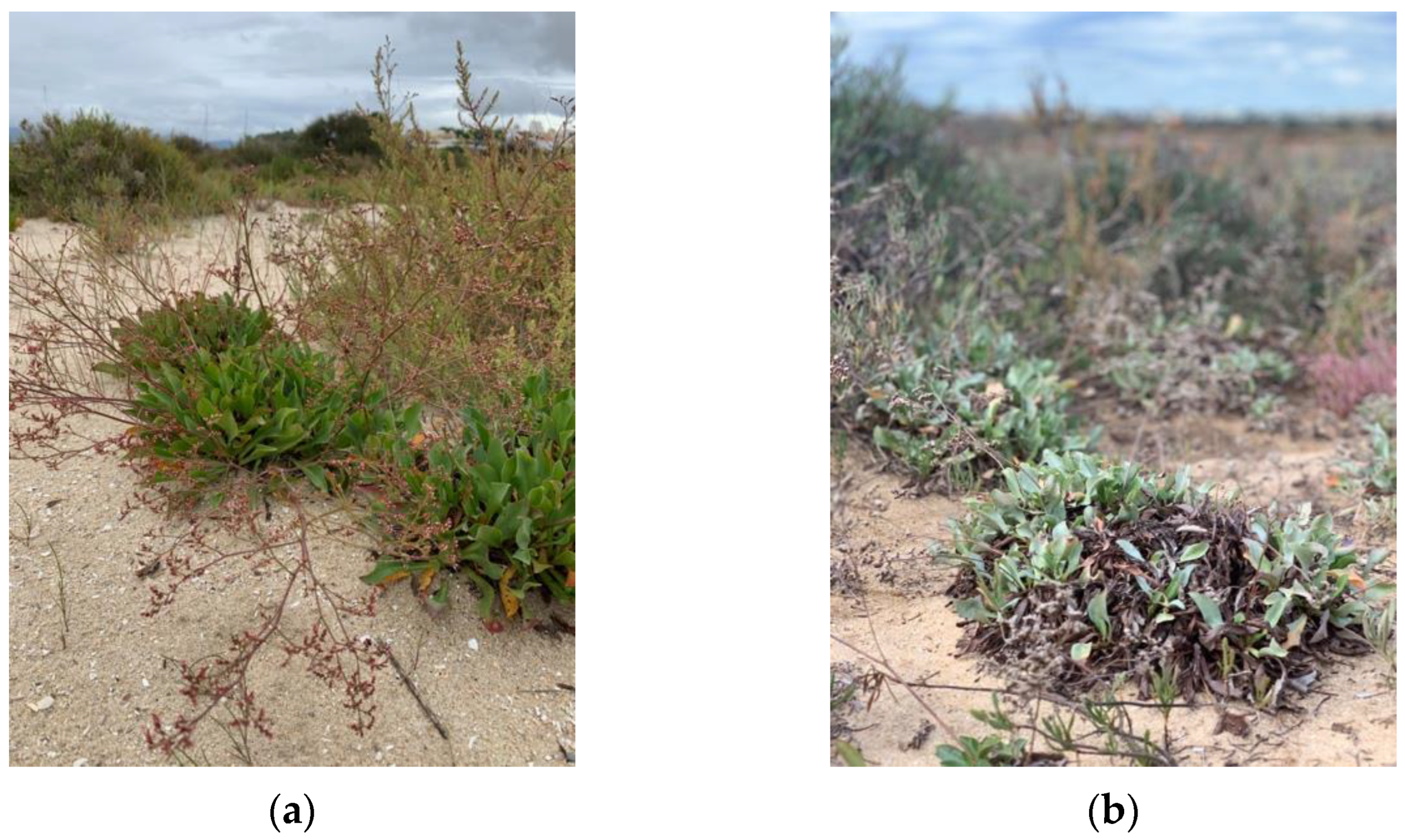
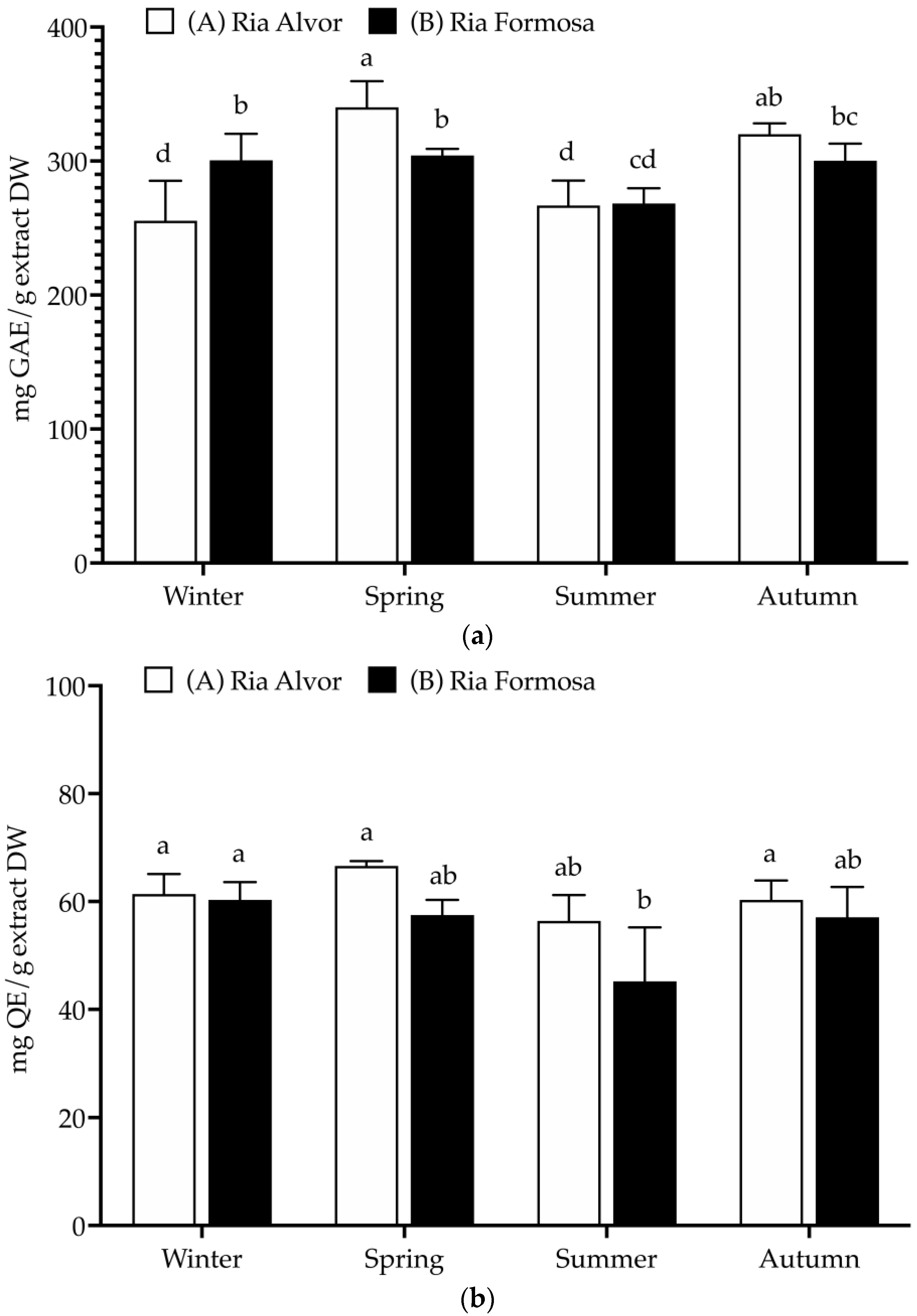
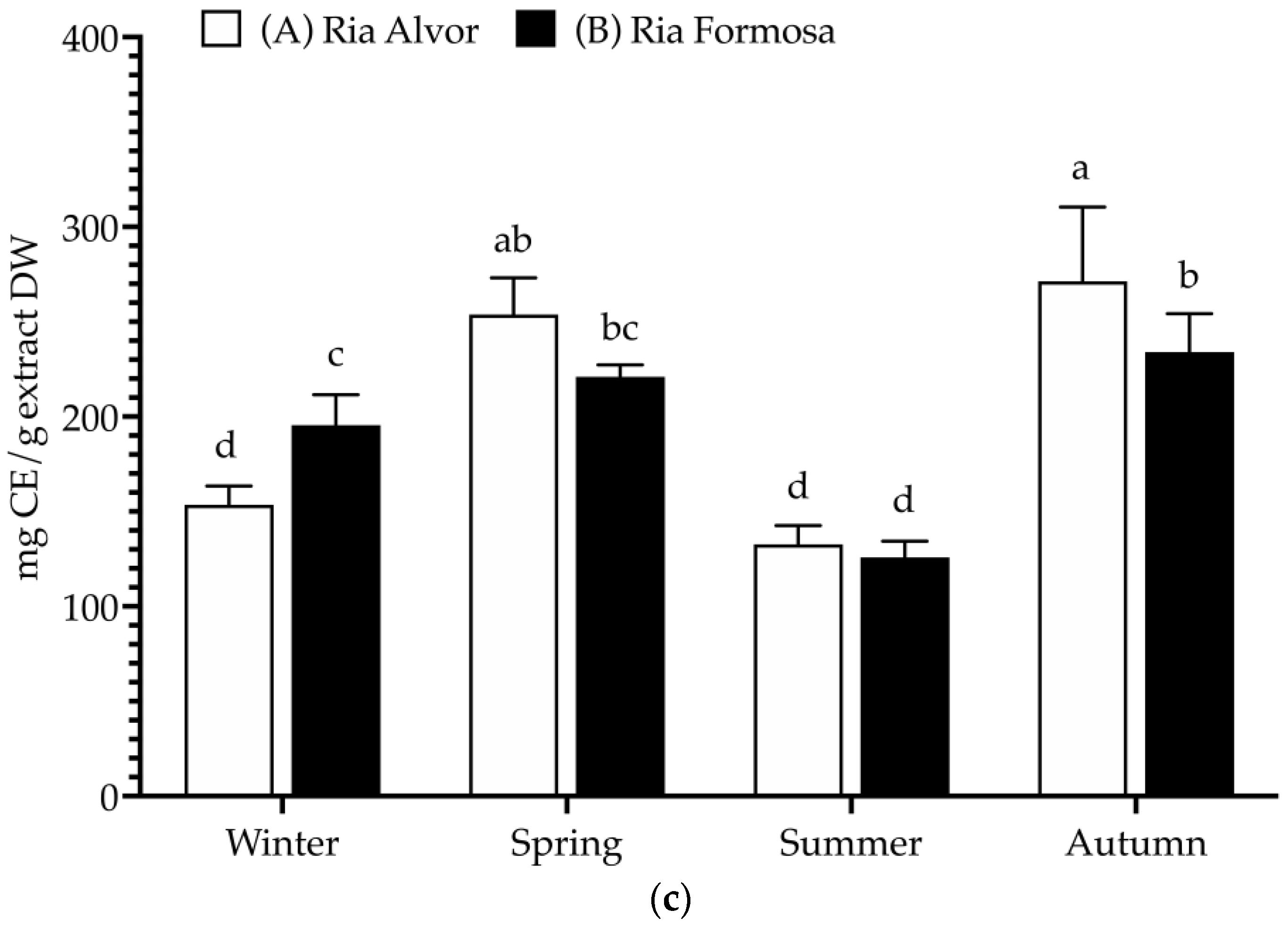
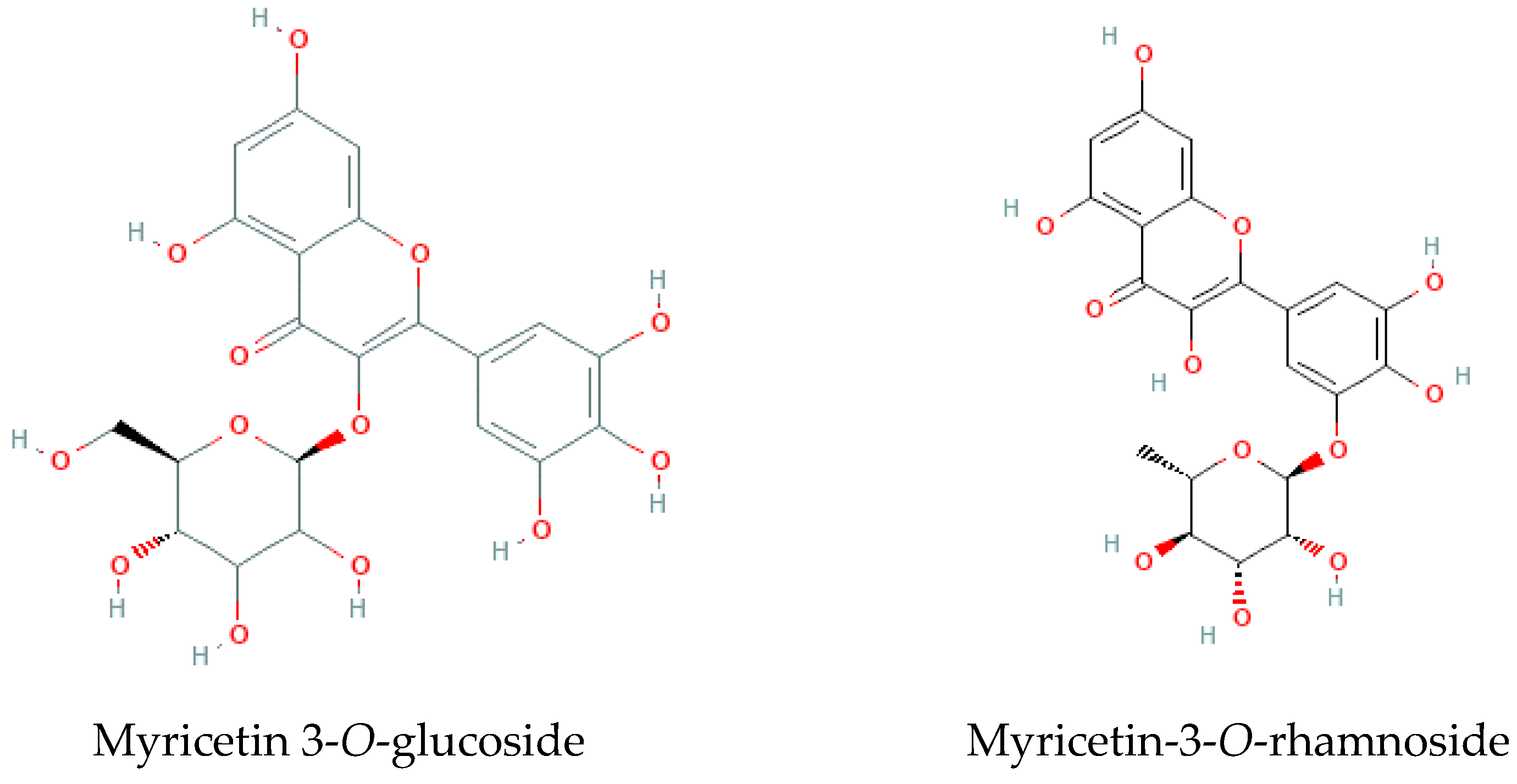
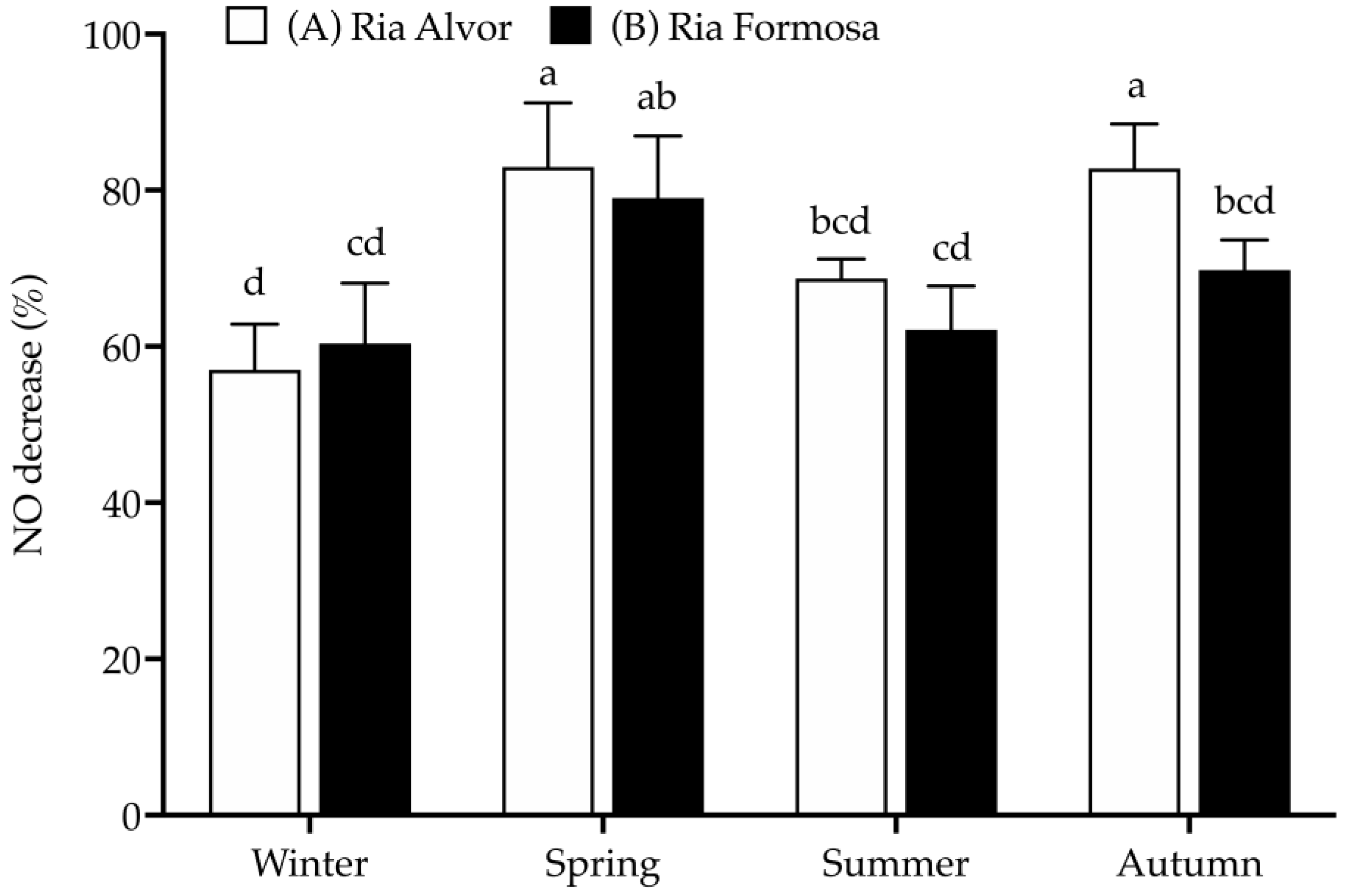
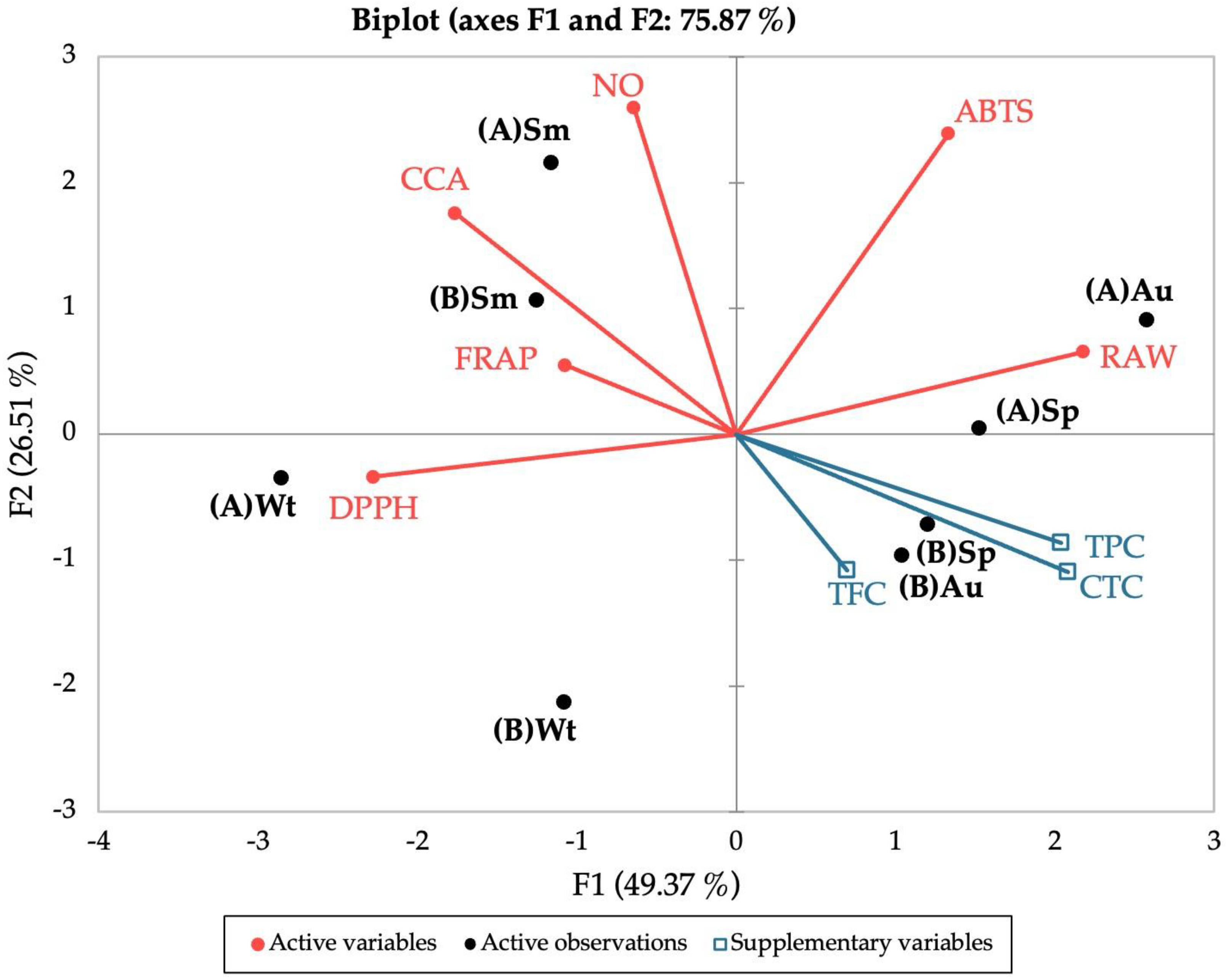
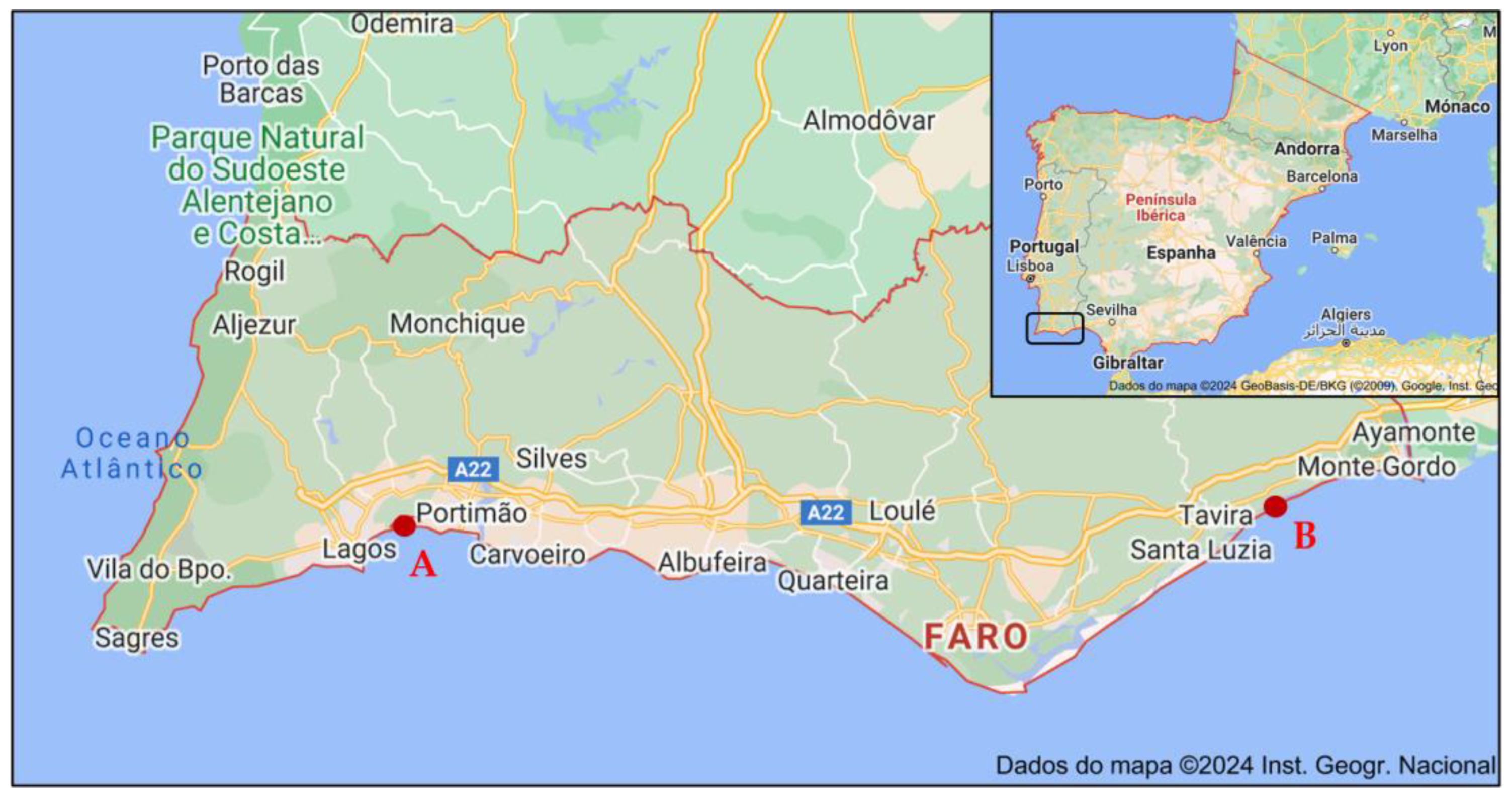
| Location/Standards | Season | DPPH• | ABTS•+ | NO | FRAP | CCA | ICA |
|---|---|---|---|---|---|---|---|
| (A) Ria de Alvor | Winter | 125 ± 6 c | 26.9 ± 3.7 a | 498 ± 38 e | 298 ± 23 de | 272 ± 15 d | Na |
| Spring | 45.6 ± 5.6 a | 73.7 ± 4.8 b | 315 ± 22 d | 333 ± 35 e | 176 ± 7 ab | Na | |
| Summer | 88.3 ± 8.1 b | 91.1 ± 5.0 bc | 703 ± 48 f | 240 ± 2. c | 338 ± 10 e | Na | |
| Autumn | 44.5 ± 4.1 a | 118 ± 4 d | 424 ± 72 e | 61.3 ± 1.1 a | 184 ± 8 b | Na | |
| (B) Ria Formosa | Winter | 92.8 ± 12.0 bc | 19.6 ± 4.0 a | 68.0 ± 2.7 a | 173 ± 14 b | 231 ± 11 c | Na |
| Spring | 62.7 ± 7.5 ab | 75.1 ± 4.7 b | 114 ± 10 ab | 273 ± 22 cd | 185 ± 4 b | Na | |
| Summer | 85.2 ± 2.4 b | 103 ± 2 cd | 270 ± 7 cd | 298 ± 11 de | 355 ± 14 e | Na | |
| Autumn | 65.6 ± 3.3 ab | 72.1 ± 7.6 b | 179 ± 12 bc | 63.3 ± 2.8 a | 193 ± 7 b | Na | |
| Positive controls | BHA | 604 ± 31 d | 330 ± 23 e | 156 ± 7 b | |||
| EDTA | 156 ± 3 a | 28.4 ± 0.3 | |||||
| Ascorbic acid | 1713 ± 18 g |
| Season | Month | Min. Temp. | Max. Temp. | Total Precipitation |
|---|---|---|---|---|
| Winter | January | 8.9 °C | 16.6 °C | 29.6 mm |
| Spring | May | 17.0 °C | 24.7 °C | 37.5 mm |
| Summer | July | 21.6 °C | 30.3 °C | 0.0 mm |
| Autumn | November | 13.7 °C | 20.0 °C | 155.8 mm |
Disclaimer/Publisher’s Note: The statements, opinions and data contained in all publications are solely those of the individual author(s) and contributor(s) and not of MDPI and/or the editor(s). MDPI and/or the editor(s) disclaim responsibility for any injury to people or property resulting from any ideas, methods, instructions or products referred to in the content. |
© 2024 by the authors. Licensee MDPI, Basel, Switzerland. This article is an open access article distributed under the terms and conditions of the Creative Commons Attribution (CC BY) license (https://creativecommons.org/licenses/by/4.0/).
Share and Cite
Pereira, C.G.; Rodrigues, M.J.; Nawrot-Hadzik, I.; Matkowski, A.; Custódio, L. Seasonal and Geographic Dynamics in Bioproperties and Phytochemical Profile of Limonium algarvense Erben. Molecules 2024, 29, 481. https://doi.org/10.3390/molecules29020481
Pereira CG, Rodrigues MJ, Nawrot-Hadzik I, Matkowski A, Custódio L. Seasonal and Geographic Dynamics in Bioproperties and Phytochemical Profile of Limonium algarvense Erben. Molecules. 2024; 29(2):481. https://doi.org/10.3390/molecules29020481
Chicago/Turabian StylePereira, Catarina Guerreiro, Maria João Rodrigues, Izabela Nawrot-Hadzik, Adam Matkowski, and Luísa Custódio. 2024. "Seasonal and Geographic Dynamics in Bioproperties and Phytochemical Profile of Limonium algarvense Erben" Molecules 29, no. 2: 481. https://doi.org/10.3390/molecules29020481
APA StylePereira, C. G., Rodrigues, M. J., Nawrot-Hadzik, I., Matkowski, A., & Custódio, L. (2024). Seasonal and Geographic Dynamics in Bioproperties and Phytochemical Profile of Limonium algarvense Erben. Molecules, 29(2), 481. https://doi.org/10.3390/molecules29020481









